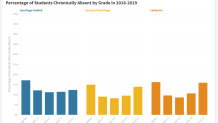Chronic absenteeism. It's a trend that hit certain grades pretty hard in the last year, not just across the state but right here in San Diego County. A new report from the Voice of San Diego shows the jarring statistics.
More than 40% of kindergarteners in the county were chronically absent from school last year, according to the report. It also found more than 45% of those kindergarteners were from San Diego Unified School District. Experts say they've never seen numbers like this, but the trend will have lasting impacts.
Chronic absenteeism is defined as when a student misses at least 10% of the school year.
"Having high levels of chronic absences with kindergarten has always been true, it’s just now, the levels of chronic absence have doubled," Hedy Chang of Attendance Works said.
Get San Diego local news, weather forecasts, sports and lifestyle stories to your inbox. Sign up for NBC San Diego newsletters.
Chang is part of the effort to reduce chronic absence in schools.
"We know if kids are chronically absent in kindergarten and first, they are much less likely to read by the end of third grade," Chang said.
A spokesperson for the district told NBC7, "in July 2022, 14 newly created Family Services Assistant positions - one for every high school cluster - started to work with families (including home visits) and schools to help decrease absenteeism by analyzing data and connecting families to the necessary support and resources."


Bridgett Pettitt has two students in county-area schools and saw the impacts first-hand.
Local
”In the beginning of the year, yes, we definitely noticed a lot more because of the COVID protocol," Pettitt said. "You had to stay out for every sniffle and get tested to make sure you were negative before you went back.”
Chang says the pandemic had a major hand in this data. Especially when comparing to the data from before the pandemic when chronic absenteeism wasn't nearly as high.
In an emailed statement, the San Diego County Office of Education told NBC 7 it has resources to address these attendance issues across all grade levels through regular training and providing materials for staff and families. According to county data, chronic absenteeism went up more than 17% in the 2021-2022 school year compared to the 2018-2019 school year.
Chang says there are several reasons that children are chronically absent, but the pandemic exasperated them.
"One, are barriers, another bucket is aversion, another bucket is disengagement, and the last one is misconceptions," Chang said.
Barriers like health challenges, getting to and from school, feelings of anxiousness, and housing insecurity only scratch the surface.
"Right now I think families are keeping kids home for any illness-related issue, when in fact for their well-being we need to be sending them to school," Chang said.
She said certain demographics are also impacted more than others.
”But the largest number is among Latino kindergarteners.”
The question is, how do the numbers improve?
"So that is going to be really important for California to look at, districts to look at, how do they make sure that schools have sufficient resources to reach out, connect to and support the kids who have been chronically absent.”
Chang also added that preschool and transitional kindergarten has historically been a key strategy for improving attendance.



